Handwriting isn’t something we practice in isolation every day. We have our handwriting notebooks and handwriting is addressed as we write together.
But lately, as I have been watching my Kindergartner and 1st grader write, I’ve noticed that they aren’t forming several of their letters the conventional way.
I jotted down a little list of the ones we needed to work on, based on my observations, and came up with a SIMPLE Handwriting Trick that got them more excited than I anticipated. {Click on the oval towards the end of this post for the freebie!}
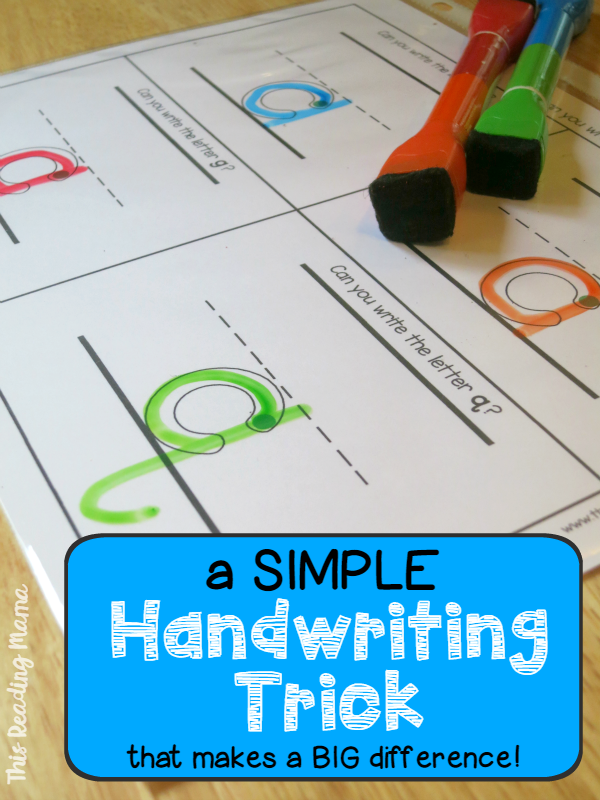
*This post contains affiliate links.
Why Does Handwriting Matter?
What is this simple handwriting trick? We’ll get to that in just a moment.
First I wanted to address this question: Why do I even care about my kids’ handwriting? There are several reasons I care, but there are two reasons I want to quickly mention.
1- Writing letters with the correct formation generally is easier on the hand and wrist. Instead of pushing the pencil across the paper, we are dragging or pulling it. Pulling the pencil across the paper doesn’t tire the hand and wrist the way that pushing it does.
2- Writing letters with conventional formation can also help the handwriting to be neater. While this isn’t always true, I find that when my kids form their letters the correct way, it’s easier for me and for them to read.
Check out our Letter Trace App. It organizes both uppercase and lowercase letters to help learners with letter formation PLUS there’s a letter reversals section!
A SIMPLE Handwriting Trick that Makes a BIG Difference
So, back to the simple handwriting trick. I went through the lower case letters in particular and grouped a few letters together by how they are formed.
For example, a, d, g, and q are all formed by starting with the letter c. My kids knew how to form a c, but would start in all kinds of places to write the other letters. I also noticed that b, h, k and t all start by forming an l first.
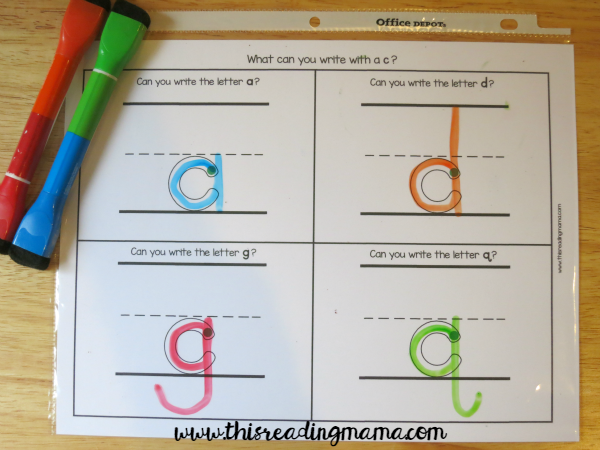
So, we practiced writing all the letters we could write by starting with c. Then we practice writing all the letters we could write by starting with l. It was truly amazing to watch their eyes light up! At one point, my first grader exclaimed, “Whoa! This is awesome!”
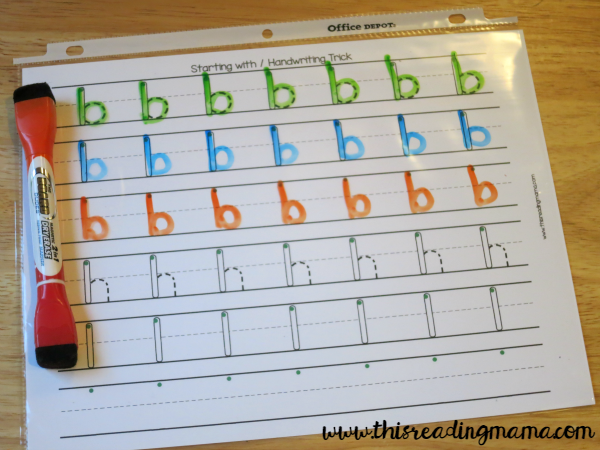
Then, I created some simple handwriting pages that they are now using for extra practice. We slipped into plastic sleeve protectors and use dry erase markers. If you look carefully, you’ll notice that each letter is practiced three times on the page.
- The first line provides a lot of support with the letter l (or c), a dot where the letter starts, and then dotted lines to complete the letter.
- The second line provides a little less support with just the l (or c) and the dot where the letter starts.
- The third line only has the dot at the top.
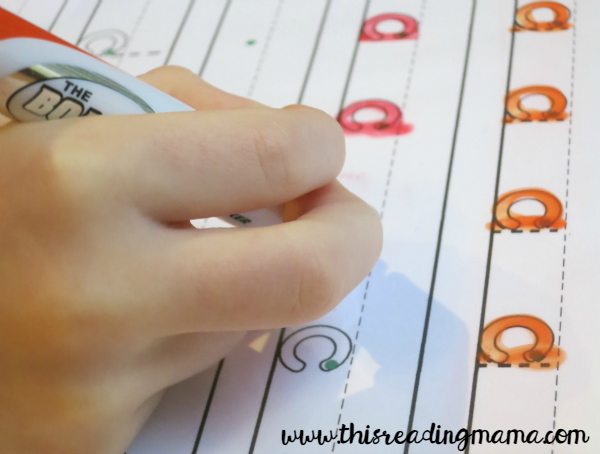
This one trick has already made a BIG difference in how my kids write some of their letters. I find myself saying, “C,” or “L,” when they forget, as just those two letters remind them of this simple handwriting trick!
Just a quite side note {as this was a concern of one reader}- I taught my kiddos that the pencil stays on the paper until the letter is finished. The only exceptions in this pack are the letters k and t.
You Might Also Like:
~Becky
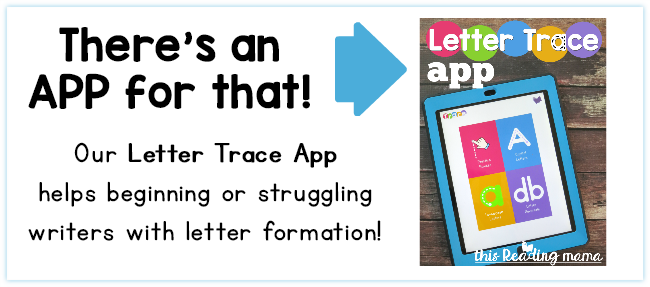
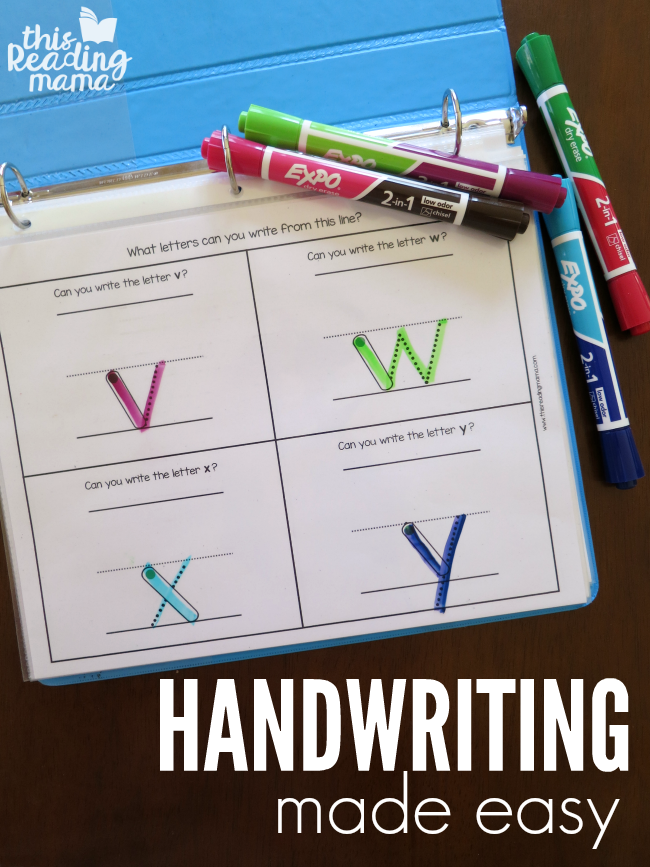

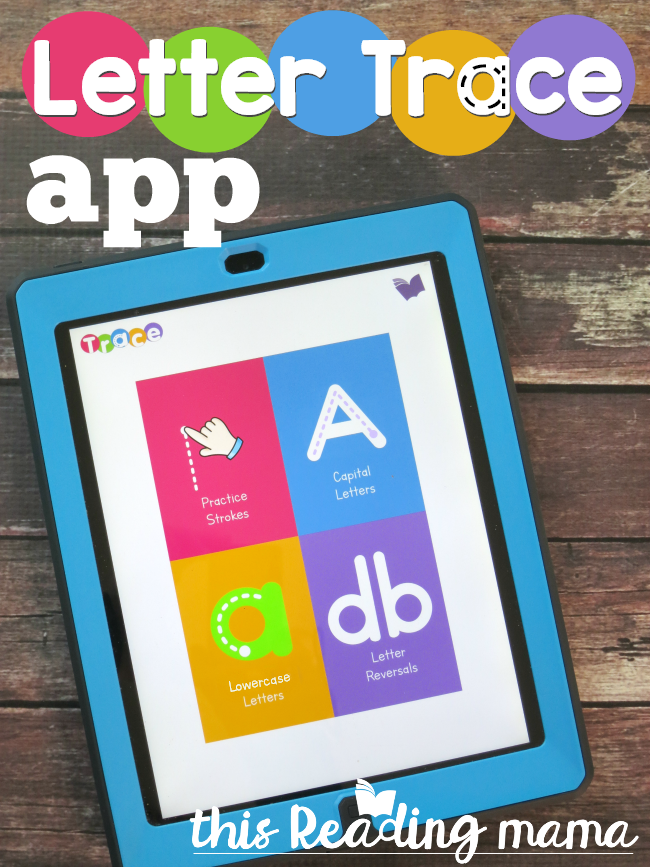

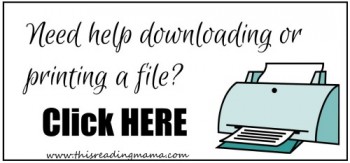
Yes! Thanks for the trick!!
Love your stuff– thank you sooooo much for sharing!
Can’t say enough how genius this is! I’m very excited to practice it with my Kindergartener!
Thank you, Jasmine!
What about for lefties? Should I be worried that my daughter does things like crosses her t’s the wrong way since that would be a pull for her rather than a push?
Yes, lefties should cross their t’s from right to left, as they need to pull and not push the pencil.
Becky, THANK YOU, thank you, thank you. I have actually been trying to teach the “magic c” as a lead in to other letters for a few years. I made up my own “printables” for the students to use. But yours are so much BETTER! I also love your simple reasons for learning correct letter formation. Many of my intervention kiddos have poor directionality when reading and writing. they form their letters every which way, which your observed in your own kids. Since letter formation is not prominent in common core standards, many teachers have abandoned teaching it. I have downloaded many of your wonderful printables, but this one has me very excited (almost panting) to get to school tomorrow and print it out for my students. Thank you. I am a reading interventionist at a public school, and your ideas are so useful to me and my students. I am so grateful that you share them FREE to everyone. Thank you. You are wonderful…and oh, so smart.Thank you!
Aw, you are so welcome! You’ve made my day!!
LOVE these–They are absolutely brilliant! Thank you!
Thank you, thank you, thank you. I had not seen this trick before. My 2nd grader is still struggling so much with so many aspects of handwriting. She writes notes to herself in all capitals since they need so little reversing or picking up of the pencil. Since the all-capital note-taking was neat, I let her go with it and let her know that draftspeople and architects have to label drawings with neat block capital letters.
As for k, a D’Nealian type can be formed without picking up one’s pencil. Then one only has to pick up the pencil to cross a t or dot an i. It doesn’t stay true to one method, but it can work.
This is similar to the method used by Handwriting Without Tears. I start that curriculum with my Pre-Kers by teaching them 4 “pieces” to use: Big Lines, Little Lines, Big Curves, and Little Curves.
What a great idea! We’ve been using Keyboarding without Tears and those terms sound familiar. They use them even there. I’ve never personally used HWT, but have heard so much about that program over the years. I was excited to learn of their “magic e” after I shared this idea.
This method is taught with the “Handwriting Without Tears” program as well! Love it! Making letters with correct formation helps with speed and legibility especially as kiddos performance damands increase.
Yes, it does! It’s similar to decoding words and comprehension. When the mind is freed up from figuring out all the words, it can usually better comprehend. Same with writing. It’s difficult to communicate a message when you’re bogged down in forming the letters. 🙂
Thanks a bunch!!! I will include this.
I can’t find where on this page to download this amazing idea…an oval? …help!
Yes, click on the oval towards the bottom of the post that says, “Click HERE to get your free printable”.
There isn’t one…maybe it’s being blocked since I’m on my school laptop. I’ll try it from home later.
Love these pages!!! Would you please consider making pages for ‘slanted line’ letters–v, w, x, and y; and ‘short line’ letters that begin at the broken line–i, m, n, r?
I actually considered the short line one, but didn’t even think of the slanted letters. Let me put it on my list. 🙂
Thank you for considering! Please let me know if you do. MsSuzieK5@gmail.com
This is SO BRILLIANT! I can’t wait to use these with my kinder and 1st grader this week!! Thanks for sharing 🙂
I am the handwriting go-to person at my school, and this is exactly how I teach it! In addition, the b starts like an h (my kids never confuse the b and d), and an r, n, m, p all start like an i.
Thank you so much for the tips !! It will really help how I teach my year 1 kids to write….. Thank you so very much.
Have you heard of Riggs, or the Orton-Gillingham method? It is a reading/writing/spelling method that is very phonogram-based. They refer to the round letters as ‘clock’ letters, and these letters start at 2:00! The b,l,i and some others are the line letters. That really struck me while I was reading this post!
What a cool idea!
I liked your handwriting trick idea so I decided to create my own chart using this same concept but putting all of the letters into five categories. The categories are: c, l, i, n and v. I call it the “S” chart. I had to stretch the idea a bit but I got them all in there. I follow your website and The Measured Mom. I’m a retired teacher. I’ve been homeschooling my daughter since fifth grade, she’s in the eleventh grade now and I tutor when her school day is done. I specialize in helping kids get “caught up” in school. I’ve just recently started to tutor dyslexic kids. I’ve been teaching for about twenty-five years. I really appreciate all the work that you do and the energy that you spend sharing it with us.
That sounds like a great way to teach handwriting! Sounds like you are very creative yourself! 🙂
Hi Becky, I’m certainly going to try this. With reference to an earlier post above do you have any tips for teaching a lefty to write? My son is really struggling with writing e.g. He writes r’s back to front and he gets b’s and d’s muddled. It’s really difficult for me to understand as I’m right handed. Any help or suggestions gratefully received!
Have you tried any of the left-handed pages I have for free on the blog–> https://thisreadingmama.com/left-handed-handwriting-pages/. Maybe that could help? I wish I knew more, as all my kiddos are right-handed.
I love this. Thanks 🙂
I found your site on handwriting tricks. Many of my kiddos struggle with writing their letters. I cant wait to use this with them. Would you happen to have the slanted line letters, v-w-x and y; and also the short line letters, i-m-n-r. Thank you again for sharing this idea with us.
It’s coming. 🙂
That’s so helpful! Thank you!
This gives me a great idea on how I can transfer this same kind of scaffolding for cursive handwriting. 🙂
I have looked until I am cross-eyed trying to find the little line handwriting trick practice pages….HELP! Thank you so much for have so much that is free because that sure does help us teachers a great deal.
Scroll towards the bottom of the post the find the teal download button. Click on that and you’ll get the PDF.
I’m so thankful to see someone that still feels handwriting and correct letter formation are IMPORTANT! This has been lost in our public schools and I find it quite frustrating. Thank you for your persistence in this and encouraging others to do the same!
genius thank you!!!
Aw, thanks. 🙂
Can someone please let me know what are the very BEST dry erase markers that will actually wipe off without ruining materials? I have tried many brands but a lot of them will ruin laminated sheets or sheet protectors. Many even mess up the nice dry erase boards that I have. What brand works the best for you?
Thanks!
I sent you an email. Did you get it?
Thanks for sharing all your downloads they are really appreciated
It’s called the magic c in my classroom!!
Thank you so much this will be so helpful.